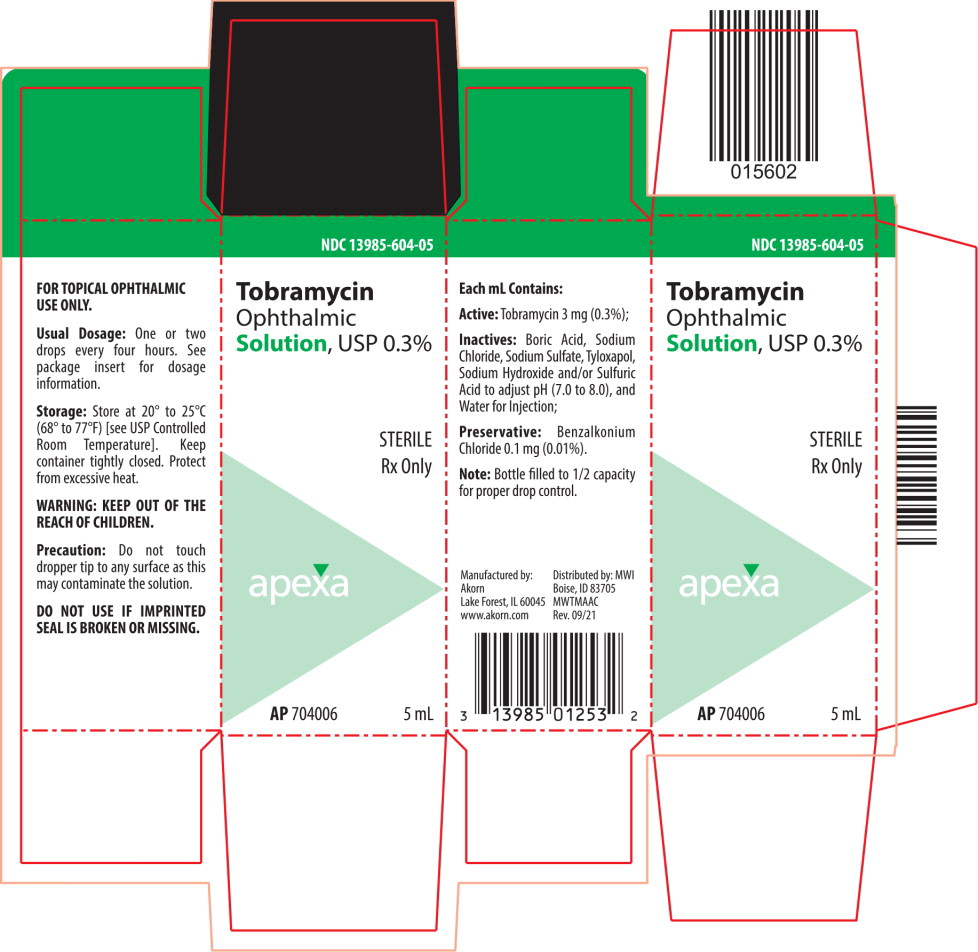Tobramycin
49dbd938-6c66-4835-af7f-923267f4568d
HUMAN PRESCRIPTION DRUG LABEL
Feb 7, 2022
MWI
DUNS: 019926120
Products 1
Detailed information about drug products covered under this FDA approval, including NDC codes, dosage forms, ingredients, and administration routes.
Tobramycin
Product Details
FDA regulatory identification and product classification information
FDA Identifiers
Product Classification
Product Specifications
INGREDIENTS (9)
Drug Labeling Information
PACKAGE LABEL.PRINCIPAL DISPLAY PANEL
Principal Display Panel Text for Carton Label:
NDC 13985-604-05
Tobramycin
Ophthalmic
Solution, USP 0.3%
STERILE
Rx Only
Apexa logo
AP 704006 5 mL

INDICATIONS & USAGE SECTION
INDICATIONS AND USAGE:
Tobramycin ophthalmic solution 0.3% is a topical antibiotic indicated in the treatment of external infections of the eye and its adnexa caused by susceptible bacteria. Appropriate monitoring of bacterial response to topical antibiotic therapy should accompany the use of tobramycin ophthalmic solution. Clinical studies have shown tobramycin to be safe and effective for use in children.
CONTRAINDICATIONS SECTION
CONTRAINDICATIONS:
Tobramycin ophthalmic solution 0.3% is contraindicated in patients with known hypersensitivity to any of its components.
ADVERSE REACTIONS SECTION
ADVERSE REACTIONS:
The most frequent adverse reactions to tobramycin ophthalmic solution 0.3% are hypersensitivity and localized ocular toxicity, including lid itching and swelling, and conjunctival erythema. These reactions occur in less than three of 100 patients treated with tobramycin.
Postmarketing Experience: Additional adverse reactions identified from postmarketing use include anaphylactic reaction, Stevens-Johnson syndrome, and erythema multiforme.
The following additional adverse reactions have been reported with systemic aminoglycosides: Neurotoxicity, ototoxicity and nephrotoxicity have occurred in patients receiving systemic aminoglycoside therapy. Aminoglycosides may aggravate muscle weakness in patients with known or suspected neuromuscular disorders, such as myasthenia gravis or Parkinson's disease, because of their potential effect on neuromuscular function.
HOW SUPPLIED SECTION
HOW SUPPLIED:
Tobramycin Ophthalmic Solution USP, 0.3% is supplied as a sterile solution in white low-density polyethylene (LDPE) plastic dropper bottle:
NDC 13985-604-05 5 mL
DOSAGE & ADMINISTRATION SECTION
DOSAGE AND ADMINISTRATION:
In mild to moderate disease, instill 1 or 2 drops into the affected eye(s) every 4 hours. In severe infections, instill 2 drops into the eye(s) hourly until improvement, following which treatment should be reduced prior to discontinuation.
SPL UNCLASSIFIED SECTION
STERILE
Rx Only
DESCRIPTION SECTION
DESCRIPTION:
Tobramycin Ophthalmic Solution USP, 0.3% is a sterile topical ophthalmic antibiotic formulation prepared specifically for topical therapy of external ophthalmic infections.
Each mL contains:
Active: tobramycin 0.3% (3 mg).Inactives: boric acid, sodium chloride, sodium sulfate, tyloxapol, sodium hydroxide and/or sulfuric acid to adjust pH (7.0 to 8.0), and water for injection.Preservative: benzalkonium chloride 0.01% (0.1 mg).
Tobramycin is a water-soluble aminoglycoside antibiotic active against a wide variety of gram-negative and gram-positive ophthalmic pathogens.
The chemical structure of tobramycin is:
Molecular Weight = 467.52
Molecular Formula: C18H37N5O9

Chemical Name: O-{3-amino-3-deoxy-β-D-gluco-pyranosyl (1→4)}-O-{2,6-diamino 2, 3, 6-trideoxy-α-D-ribohexo- pyranosyl-(1→6)}-2-deoxystreptamine.
CLINICAL PHARMACOLOGY SECTION
CLINICAL PHARMACOLOGY:
In Vitro Data: In Vitro studies have demonstrated tobramycin is active against susceptible strains of the following microorganisms:
Staphylococci, including S. aureus and S. epidermidis (coagulase-positive and coagulase-negative), including penicillin-resistant strains.
Streptococci, including some of the Group A beta-hemolytic species, some nonhemolytic species, and some Streptococcus pneumoniae.
Pseudomonas aeruginosa, Escherichia coli, Klebsiella pneumoniae, Enterobacter aerogenes, Proteus mirabilis, Morganella morganii, most Proteus vulgaris strains, Haemophilus influenzae and H. aegyptius, Moraxella lacunata, Acinetobacter calcoaceticus and some Neisseria species. Bacterial susceptibility studies demonstrate that in some cases, microorganisms resistant to gentamicin retain susceptibility to tobramycin.
WARNINGS SECTION
WARNINGS:
FOR TOPICAL OPHTHALMIC USE ONLY. NOT FOR INJECTION INTO THE EYE. Sensitivity to topically applied aminoglycosides may occur in some patients. Severity of hypersensitivity reactions may vary from local effects to generalized reactions such as erythema, itching, urticaria, skin rash, anaphylaxis, anaphylactoid reactions, or bullous reactions. If a sensitivity reaction to tobramycin ophthalmic solution 0.3% occurs, discontinue use.
PRECAUTIONS SECTION
PRECAUTIONS:
General: As with other antibiotic preparations, prolonged use may result in overgrowth of nonsusceptible organisms, including fungi. If superinfection occurs, appropriate therapy should be initiated.
Cross-sensitivity to other aminoglycoside antibiotics may occur; if hypersensitivity develops with this product, discontinueuse and institute appropriate therapy. Patients should be advised not to wear contact lenses if they have signs and symptoms of bacterial conjunctivitis.
Information for Patients: Do not touch dropper tip to any surface, as this may contaminate the solution.
Pregnancy Category B: Reproduction studies in 3 types of animals at doses up to 33 times the normal human systemic dose have revealed no evidence of impaired fertility or harm to the fetus due to tobramycin. There are, however, no adequate and well-controlled studies in pregnant women. Because animal studies are not always predictive of human response, this drug should be used during pregnancy only if clearly needed.
Nursing Mothers: Because of the potential for adverse reactions in nursing infants from tobramycin, a decision should be made whether to discontinue nursing the infant or discontinue the drug, taking into account the importance of the drug to the mother.
Pediatric Use: Safety and effectiveness in pediatric patients below the age of 2 months has not been established.
Geriatric Use: No overall clinical differences in safety or effectiveness have been observed between the elderly and other adult patients.
STORAGE AND HANDLING SECTION
STORAGE:
Store at 20° to 25°C (68° to 77°F) [see USP Controlled Room Temperature]. Keep container tightly closed. Protect from excessive heat."
apexa™
Manufactured by: Akorn
Lake Forest, IL 60045
Distributed by: MWI
Boise, ID 83705"
MWTM00N Rev. 09/21
